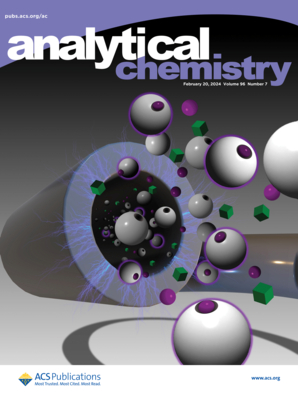Colorimetric-Assisted Photoelectrochemical Sensing for Dual-Mode Detection of Neuron-Specific Enolase via the Photoanode-Photocathode System.
IF 6.7
1区 化学
Q1 CHEMISTRY, ANALYTICAL
引用次数: 0
Abstract
Convenient and accurate detection of neuron-specific enolase (NSE) is crucial for small cell lung cancer. However, due to the shortcomings of a single detection mode such as insufficient reliability, a dual-mode signal response system based on photoelectrochemical (PEC) and colorimetric methods was developed in this paper for the ultrasensitive detection of NSE. In the PEC method, the ITO/Nb2O5/CdS composite was used as the photoanode and ITO/BiOI as the photocathode based on the energy level matching principle, which greatly enhanced the anti-interference ability of the photocurrent. In addition, MnO2 has oxidase-like property and can effectively oxidize 3, 3', 5, 5'-tetramethylbenzidine to produce a blue product, thus enabling colorimetric detection of NSE. The constructed PEC immunosensor demonstrated commendable performance within the linear range of 1.0 pg/mL-100 ng/mL, achieving the detection limit of NSE at 0.25 pg/mL. For the colorimetric analysis, effective detection was accomplished within the range of 0.5 ng/mL-30 ng/mL, with a detection limit of 0.13 ng/mL. The dual-mode analysis strategy that combines photoelectrochemistry and colorimetry realized highly sensitive and accurate detection of NSE.利用光阳极-光电阴极系统进行神经元特异性烯醇化酶双模检测的比色辅助光电传感。
方便、准确地检测神经元特异性烯醇化酶(NSE)对小细胞肺癌的诊断至关重要。然而,由于单一检测模式存在可靠性不足等缺点,本文开发了一种基于光电化学(PEC)和比色法的双模信号响应系统,用于NSE的超灵敏检测。在PEC方法中,基于能级匹配原理,采用ITO/Nb2O5/CdS复合材料作为光阳极,ITO/BiOI作为光电阴极,大大增强了光电流的抗干扰能力。此外,MnO2具有类似氧化酶的性质,可以有效氧化3,3 ',5,5 '-四甲基联苯胺生成蓝色产物,从而可以比色检测NSE。所构建的PEC免疫传感器在1.0 pg/mL-100 ng/mL的线性范围内表现出良好的性能,NSE的检出限为0.25 pg/mL。比色分析在0.5 ng/mL ~ 30 ng/mL范围内有效检测,检出限为0.13 ng/mL。采用光电化学与比色法相结合的双模分析策略,实现了NSE的高灵敏度、高精度检测。
本文章由计算机程序翻译,如有差异,请以英文原文为准。
求助全文
约1分钟内获得全文
求助全文
来源期刊

Analytical Chemistry
化学-分析化学
CiteScore
12.10
自引率
12.20%
发文量
1949
审稿时长
1.4 months
期刊介绍:
Analytical Chemistry, a peer-reviewed research journal, focuses on disseminating new and original knowledge across all branches of analytical chemistry. Fundamental articles may explore general principles of chemical measurement science and need not directly address existing or potential analytical methodology. They can be entirely theoretical or report experimental results. Contributions may cover various phases of analytical operations, including sampling, bioanalysis, electrochemistry, mass spectrometry, microscale and nanoscale systems, environmental analysis, separations, spectroscopy, chemical reactions and selectivity, instrumentation, imaging, surface analysis, and data processing. Papers discussing known analytical methods should present a significant, original application of the method, a notable improvement, or results on an important analyte.
 求助内容:
求助内容: 应助结果提醒方式:
应助结果提醒方式:


